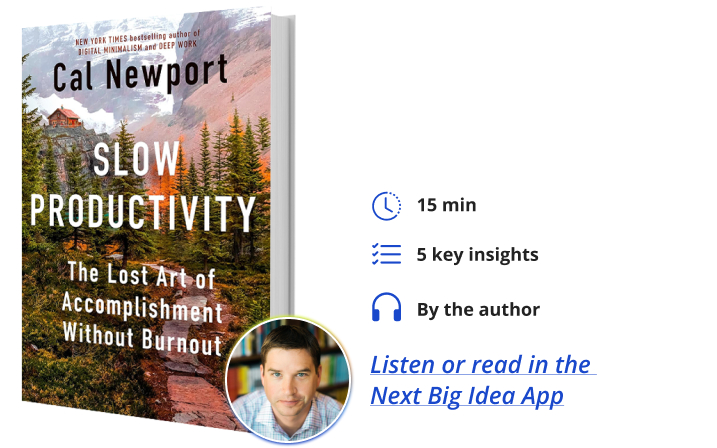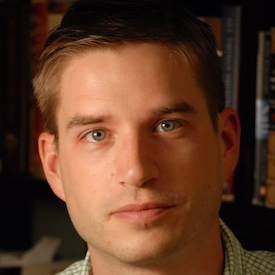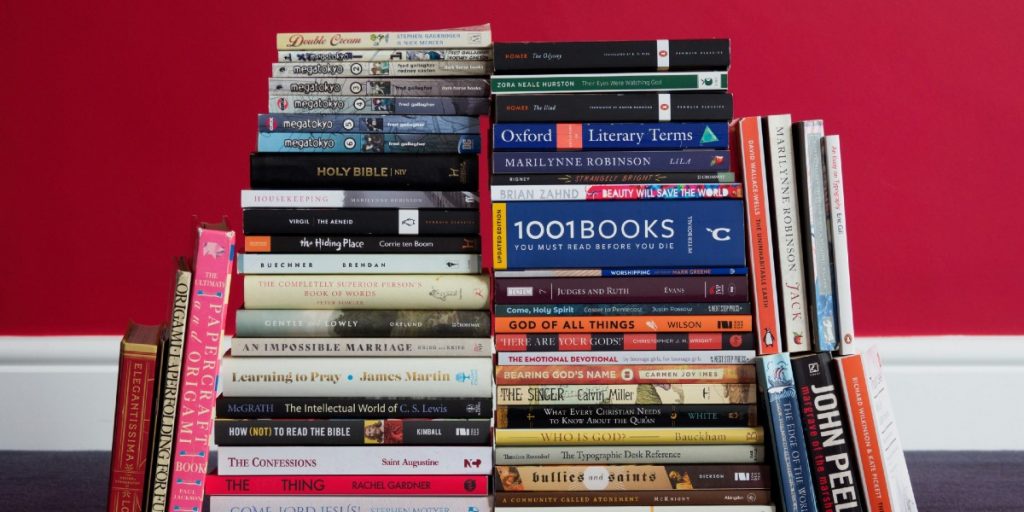Cal Newport is a professor of computer science at Georgetown University and a founding member of the Center for Digital Ethics. He is also a New York Times bestselling author, contributor staff for The New Yorker, and hosts the popular Deep Questions podcast.
Below, Cal shares five key insights from his new book, Slow Productivity: The Lost Art of Accomplishment Without Burnout. Listen to the audio version—read by Cal himself—in the Next Big Idea App.

1. Busy is not the same as productive.
In the late 1960s, John McPhee was working on an epic New Yorker piece about the Pine Barrens. He was stuck. He didn’t know how to make sense of all the research he had gathered, and he found himself lying on a picnic bench in his backyard, staring up at a tree. He did this for five days in a row. He was trying to figure out how to make the article work. Now, here’s my quiz. If we came upon John McPhee in his backyard in the late 60s on his picnic table, and I asked you if he was productive or not, what would you say?
There’s tension here. Our modern inclination tells us that this person is not productive. He’s not doing anything; he’s just laying here. However, at the same time, we know of course that John McPhee is productive. He’s one of the most productive writers of his generation. He’s written 29 books, he has won a Pulitzer Prize, he was the finalist for a national book award two different times. His body of work for the New Yorker is incomparable—so of course he’s productive.
Clearly something must be wrong with our modern definition of productivity. The issue is that our modern definition focuses on busyness, referred to also as pseudo-productivity. This idea is that visible activity is a good proxy for useful effort. But as John McPhee’s experience teaches us, that’s not always the case. Busyness is its own thing, and could be completely unrelated to whether or not you are productive.
2. You should do fewer things.
Most modern knowledge workers brag about how long their task lists are. In fact, they often need special software to keep track of all the different things they have committed to doing. Here’s the problem with that: almost everything that you agree to do brings with it administrative overhead. There are emails that have to be sent, weekly standing meetings you have to attend, and you have to use cognitive real estate dedicated to worrying about this thing that you said you were going to do. The so-called overhead tax aggregates.
The more things you have agreed to do, the more overhead tax you’re paying, which means the more of your day is dedicated to the administrative support of your to-do list and not the actual execution of the tasks themselves. This is a vicious cycle because it means you have less time to do the actual work, so you fall farther behind. More things get added to the end of this list, and you fall even farther behind. The end result is these crazy situations, now common in modern knowledge work, where almost all of your day is spent in Zoom meetings, talking about work, while you’re simultaneously slacking or emailing about other projects.
“Be realistic about how much work you actually have to do.”
We talk about work, but we barely have time to do it. This is fine if you embrace pseudo-productivity and are looking for busyness. But for a slower notion of productivity, this is a disaster and makes us miserable.
As a remedy, you can do fewer things at once. One of the easiest ways to accomplish this is to start being realistic about your actual workload. When someone asks you to do something for them, be willing to say, “Yes, here’s my work status document. You can see the three things at the top are priority projects I’m working on right now. Below that are seven or eight things that are queued up in the order that I currently plan to tackle them. Just add yours right there at the end. Please append the information I need to accomplish it, and you should be able to estimate when I’ll get to that by looking at this long queue of work.”
Be realistic about how much work you actually have to do. Stop pretending like you have infinite capacity and that you can do anything anyone asks you whenever they want you to do it. This is not saying no to people. It is just forcing other people to confront the reality of your workload. When you’re realistic about your workload, you can work on a realistic number of things at a time.
The cool side effect of this approach is that it makes your life better because you’re not as overloaded and you also produce more. When only a small fraction of your day is dedicated to the administrative overhead of ongoing active projects, much more of your time is focused on doing those projects. Therefore, you start churning through the things you need to do faster. Doing fewer things at once does not mean finishing fewer things. If anything, it means you’ll finish more things per year, but do so on a much more human pace and scale.
3. You should take longer on things that matter.
Here is how most people implicitly make timelines for important projects that they decide that they’re going to commit. They think of their best-case scenario and then get really excited about that. We fall in love with the best-case scenario, and then that’s how we decide that’s what’s true. Of course, the best-case scenario never happens. Way more work comes up than we were estimating, things take longer than we were thinking, we get sick for a week, and we end up with too much on our plate once again for being overly ambitious. We had visions for how quickly we’re going to get work done and then we don’t. Everything then begins to overlap.
“By taking more time, you give yourself the time you need to do something well, and you avoid the overlap and overload that could hold you back from producing at your fullest capacity.”
The simple solution is to expand those timelines. When you’re thinking about how long something is going to take, come up with whatever idea feels good to you, then add 50 to 100 percent to that realistic timeline. When we study traditional knowledge workers—people who use their brains to make a living throughout history—we realize that they took their time. Even someone like Isaac Newton, while working on the Principia, actually took most of his adult lifetime to finish it. A recent example is Lin Manuel Miranda, who was working on his first great play In the Heights for eight years before it made its Broadway debut. By taking more time, you give yourself the time you need to do something well, and you avoid the overlap and overload that could hold you back from producing at your fullest capacity.
It might feel intolerably slow in the moment, but when you zoom out, you’re getting good things accomplished realistically.
4. Escape the invisible factory.
There is an idea that work happens during a workday, and you should really be working hard during that workday. You can then take the weekends off and, maybe once a year, take a week or two of vacation. But work is at full intensity all day long, including most days, most weeks, and most months of the year. Here’s the thing, however, that’s very artificial.
For most of human history, though, what we might call work varied wildly in intensity over time. If we look back to the Paleolithic period, the 200,00 to 300,000 years in which anatomically modern homo sapiens were around, the rhythms of nature dictated what our day was going to be like. It’s raining, so we’re doing nothing. I’m on a hunt during the midday sun, so I will conserve energy. But during a stalk that happens near dusk, I’m running for three hours in a row. There are all sorts of variations. Then there is the agrarian revolution and the neolithic revolution. Now, we are farming, but this work is quite literally seasonal. The harvest season is incredibly busy. The winter is much less busy.
Throughout history, we had all sorts of variations in work intensity. This finally changes much more recently in this grand scope of the human experience, when we get the industrial revolution with the construction of automated mills followed by factories. This is the first time in human history, at a large scale, where we found ourselves confronted with economic activity where more is always better. The longer we ran the factory, the more we produced, the more profit margin we were able to leverage, and the more money we were able to make. It was the mill and the factory where we invented this idea of a shift.
Nowadays, you come to work every day, whether it’s December or June, and you work as hard as you can all day long. This is incredibly unnatural. We didn’t evolve for this. It is alien to all of our experience with work up until this point. This is why these mills and factories were intolerable. It led to the creation of labor unions. It led to the creation of whole regulatory frameworks, all of which were recognizing the artificiality of trying to make people work real hard all day with no variation.
“We need to escape this invisible factory model and introduce more variation of intensity into how we approach knowledge work.”
Then, knowledge work comes around in the mid-20th century. At that point, we had to figure out how to structure knowledge work since people didn’t need people to be in factories. We decided to borrow the industrial metaphor: eight hours days, work really hard, pseudo-productivity. If you’re seen not doing activity at any point during this day, it looks suspicious. You’d better work really hard.
We created an invisible factory in the world of knowledge work. But when it comes to producing information from your mind, just like with farming or with hunting or foraging, the factory model doesn’t work well. Some periods, we need to think really hard; other periods, we need to recharge from the hard thinking. Some periods, we need to be unstructured to try to find insight. In other periods, we need to be very carefully sifting through our brainstorms to come up with something new. Cognitive intensity should vary wildly if you’re going to produce really high-end cognitive work sustainably. We need to escape this invisible factory model and introduce more variation of intensity into how we approach knowledge work.
If you actually run a company or a team, you could do this formally. You can do this using cycles. You work on a key project in a cycle of four to six weeks. When you’re done with that project, you down-cycle for two weeks. You don’t start something new. Your work is much less intense. Reflect on what you just did and clean up loose ends. You plan what’s going to happen next. Don’t jump into a new cycle. Resist that urge. Take your full down cycle period before you wind back up again. Academics have sabbaticals. This is something that is sweeping through other industries as well. More and more companies now suggest doing three years of hard work. After the three years, you then get three or four months off or of reduced intensity so you can recharge. This way, you won’t burn out.
Even if your employer does not like this idea of variation and effort, do it on your own. Just do it quietly without making a big deal about it. Downshift for December and then upshift again in January. This could make a big difference for you and your brain, your physiology, and the sustainability of your job. Your employer probably won’t notice it all. The invisible factory was a bad idea, and we need to escape it.
5. You should obsess over quality.
You should care a lot about your craft. You should care a lot about wanting to do what you do best, as good as possible, and pushing that skill. This is not just trying to apply the skill at the highest level you’re capable of but, over time, improving that skill.
Why is this so important? Obsessing over quality is tightly connected to being able to slow down, to get away from a busyness-based definition of productivity. There are two different effects happening here.
- The more you care about the quality of your craft, the more you’ll feel like you need to slow down. If what you care about is doing what you do—the computer code, the marketing, the marketing copy that you produce, the business strategy, the book chapters —then busyness is going to feel like an obstacle. Busyness is going to feel like something that’s pulling you away from what really matters. So, you will naturally drift away from a busyness-based definition of productivity when quality is what you care about.
- Also, as you get better at things, your value to the marketplace goes up. As your value to the marketplace goes up, you get more leverage over your career and you can use that leverage to slow things down. You can do that leverage to reduce what’s on your plate. You could use that leverage to take more time or to take breaks or to vary your intensity. It becomes your key tool for embracing a slower notion of productivity. Obsessing over quality might be the single most important thing you can do to make your working life much more sustainable.
Hopefully, I have convinced you that our current approach to knowledge work mired in the admiration of busyness is broken and has to go. Other alternatives are possible. They replace fastness with slowness. They replace exhaustion with sustainability and meaning. Work can be better than it is, and if we slow down, it will be.
To listen to the audio version read by author Cal Newport, download the Next Big Idea App today:































